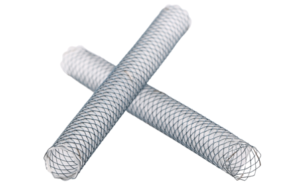Endoscopy Supplies
Gastroenterology
- Niti-S™ Self-Expandable Metal Stent
- RFA Treatment
- Solar™ GI High-Resolution Manometry Available In Canada
- Solid State Catheters Available in Canada
Available In The USA
Interventional Radiology S-Type Covered Biliary ™ Stent
Category: Interventional Biliary Stents

Enhanced Safety Measures with Flared Ends: Mitigating Migration Risk. The Complete PTFE Body Encasement, Coupled with a Silicone Flare Shield and a Convenient Removal String at the Proximal Terminus, Ensures Hassle-Free Extraction. Enhanced Visibility with Three Radiopaque Markers at Each Terminus and an Additional Pair at the Center.
Product Description
- Fixed cell with braided construction
Flexible and resistant to fracture - Atraumatic ends
Less hyperplasia at the edges - Silicone covering on both inner and outer surface
Prevent the risk of tumor ingrowth
Help smooth bile flow - Retrieval string facilitates safe and smooth removal
- Radiopaque marker: 3 (three) at both ends and 2 (two) in the middle
Indication
Benign and malignant biliary strictures
Clinical Reference
- Placement of a 6 mm, fully covered metal stent for main pancreatic head duct stricture due to chronic pancreatitis: a pilot study (with video)
by Takeshi Ogura et al [Therap Adv Gastroenterol. 2016 Sep;9(5):722-8] - Intraperitoneal rendezvous: a mini-invasive biliary reconstruction
by Gabriele Curcio, MD et al [Gastrointest Endosc. 2016 Jul;84(1):184-5] - Chronic pancreatic pain successfully treated by endoscopic ultrasound-guided pancreaticogastrostomy using fully covered self-expandable metallic stent
by Arunchai Chang et al [World J Clin Cases. 2016 Apr 16;4(4):112-7] - Endoscopic ultrasound-guided hepaticogastrostomy using a 6-F cystotome and 12-cm covered metal stent
by Mandai Koichiro et al [Endosc Int Open. 2016 Mar;4(3):E287-91] - Clinical Outcome of Endoscopic Ultrasound-Guided Liver Abscess Drainage Using Self-Expandable Covered Metallic Stent (with Video)
by Takeshi Ogura et al [Dig Dis Sci. 2016 Jan;61(1):303-8] - Fully covered self-expandable metal stent treatment of spurting bleeding into the biliary tract after endoscopic ultrasound-guided fine-needle aspiration of a solid lesion of the pancreatic head
by Luca Barresi et al [Endoscopy. 2015;47 Suppl 1 UCTN:E87-8] - Polyurethane-Covered Self-Expandable Nitinol Stent for Malignant Biliary Obstruction: Preliminary Results
by Young-Min Han et al [Cardiovasc Intervent Radiol (2002) 25:381–387]
- Placement of a 6 mm, fully covered metal stent for main pancreatic head duct stricture due to chronic pancreatitis: a pilot study (with video)
Key Resources
Interventional Radiology S-Type Covered Biliary™ Stent: Innovating the Way We Treat Biliary Strictures
In the ever-evolving field of interventional radiology, the S-Type Covered Biliary™ Stent has emerged as a groundbreaking solution for managing biliary strictures. These specialized stents have revolutionized the way we treat this condition, providing patients with effective relief and enhancing their quality of life.
Unlike traditional stents, the S-Type Covered Biliary™ Stent is uniquely designed to minimize the risk of complications. It features a proprietary covering that prevents stent migration, reduces the risk of bile leakage, and promotes a smoother passage of bodily fluids. This innovation not only ensures patient comfort but also minimizes the need for frequent stent replacement, saving time and healthcare costs.
Moreover, interventional radiologists appreciate the stent’s ease of deployment, which significantly shortens procedure times. Its adaptable design allows for precise placement, optimizing patient outcomes.
As we delve deeper into the era of minimally invasive interventions, the S-Type Covered Biliary™ Stent represents a pivotal development in interventional radiology, providing hope, relief, and improved patient experiences in the realm of biliary strict.
